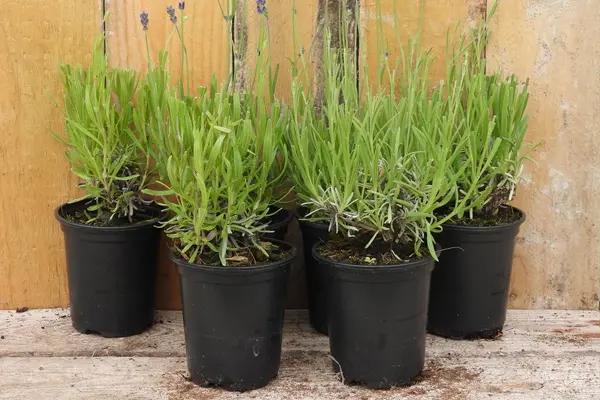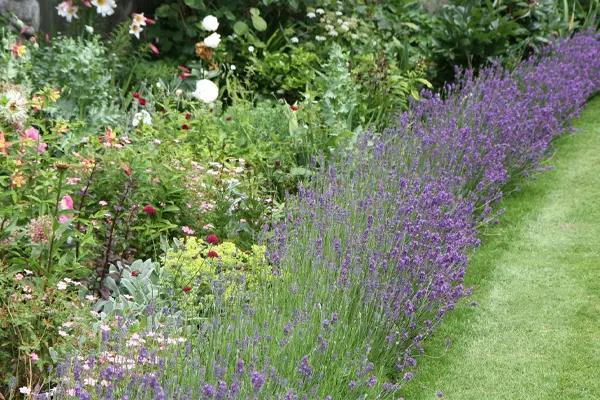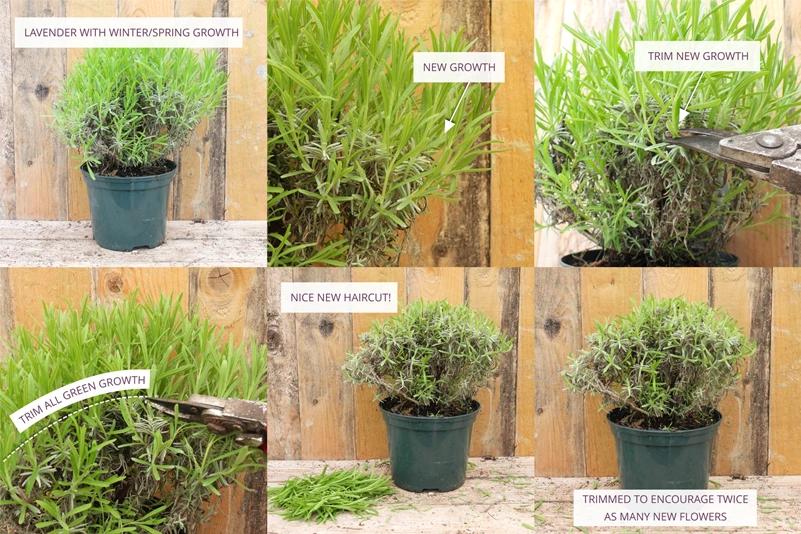We start delivering Lavender plants each year when the weather warms up in April.
Table of Contents
How to Grow Lavender
- Good drainage is most important: Lavender is cold hardy, but damp soil in Winter is bad for the roots. Dry, poorly fertile soils are ideal.
- Lavender needs close to full sun to thrive and flower densely.
- It prefers poor soil and thrives in exposed coastal sites.
- When established, they are drought-tolerant, but in their first and second year you must water them well, as with any new shrub.
Don’t plant lavender out too early in Spring: the cold soil will shock the roots.
In most years for most of the UK, wait until warm nights arrive in May, even June in the coldest Northern regions.
Deer and rodents are not interested in mature lavender foliage; they might nibble fresh green Spring growth.
Which variety should I choose?
In the sunnier South, all varieties will be fine outdoors, in suitably well drained soil and sunny aspect.
In colder regions, the issue is longevity.
- Lavandula angustifolias Hidcote and Munstead are the hardiest, best for growing outdoors year round across the UK.
- Lavandula x intermedia, the Dutch lavandins, are also suitable for growing outdoors in most of the UK.
- Lavandula stoechas, the butterfly Lavenders, in many British gardens, will stay attractive and healthy for longer in pots that are taken indoors overwinter, to a conservatory or big South facing window.
Which size should I buy?
The starting size affects the cost, and the speed of establishment into a mature, hard working plant with lots of flowers.
- For window boxes and other cramped spaces, start with the smallest plants, which come in P9 pots and are a year old.
If you plant them outside, do it from the end of May when the soil is nice and warm. They are also the cheapest way to buy a lavender hedge, you only have to wait a couple of years longer for them to knit together and to start flowering well.
Many experienced Lavender growers like to start with p9s because they can prune them perfecty from that small size.
P9s are not recommended for planting out late in the season, because they won’t have time to establish before Winter.
Much better to pot them up into 1 litre pots, keep them in a sheltered place overwinter, and plant them out in Spring when the soil is warm. - For instant impact, larger plants in 2 litre pots are great, and only about twice the price. You get more root and more flower in the first year, and they do not look lost planted at 13″ (33cm) spacing. By the end of the first summer, the row should have joined up.
- If you are shopping at a garden centre for even larger Lavender plants, we don’t recommend pot sizes above 5 litres: they are expensive, but the results are often “uneven”.
If these large plants are on a special offer discount, they may also have outgrown their pot and so are too pot bound to establish well elsewhere!

How to prepare a Lavender bed
It makes sense to plant where you pass by often, so that you can enjoy the fragrance.
The best soil for Lavender is poor and free-draining
The richer the soil, the less fragrant your Lavender will be, and the shorter its attractive lifespan.
- Remove weeds and break up soil compaction, so the new roots can spread out rapidly both down and sideways.
- To improve drainage, it helps to raise the soil level a little by forking in plenty of grit and sharp sand, however, this is not usually practical beyond a small ridge or mound: growing Lavender in a pot is much easier than raising the level of a whole bed!
Choose your position
- Like most plants with tough, narrow, silvery leaves and small flowers, it loves a hot, open, sunny position, facing south or west.
- It tolerates a little shade but needs full sun for most of the day. It does not like growing right under trees, even if they cast light shade.
- It can tolerate severe cold by British standards, but it hates wet areas. Good drainage is vital: if your soil waterlogs in winter, your lavender will deteriorate quickly!
- It thrives by the sea and is wind resistant.
Did you know? Lavender is the most misplanted plant in the UK, because people love it so much that they plant it in damp shady places regardless of the fact it won’t last long after the first year.
Can I grow Lavender in the Shade?
- Every garden resource will tell you that no, you cannot grow Lavender in the shade; it needs full sun to thrive.
- That is true, but that does not stop people from planting it on the darkside anyway!
- A healthy Lavender plant that we deliver to you in a pot 1 litre or larger has enough stored energy to last a couple of years in low light conditions before it really starts to decline.
- So you could grow Lavender against a North facing wall with no direct sunlight as a short-lived perennial that you threw away after a few years when it got too lanky and sparse from reaching for the light.
Preparing the ground
- The ideal pH is neutral to alkaline. It does really well on shallow chalk. If your soil is slightly acidic, then adding lime will help increase the pH. A handful per square metre (with an application every spring) is likely to be enough, but always follow the instructions on the packet.
- Poor, sandy soil with low fertility and great drainage is ideal, so do not add anything to improve it unless you are on close to pure sand, in which case a sprinkle of compost will help them establish. With rich soil, you will get more foliage, fewer flowers, and your plants will age faster, in the sense of getting leggy.
- Dig it over, remove detritus and thoroughly get the weeds out (much easier now than later).
- If the weather is cold leading up to planting time, then covering the area with black plastic for a couple of weeks before you receive the plants will help raise the soil temperature.
Lavender and heavy clay soil
It will tolerate clay soil, given a warm, sunny position where water doesn’t linger in wet weather, like at the top of a bank. However, it tends to become woodier at the base, and shorter lived.
Optional ways to increase drainage and oxygen held in the soil:
- Dig in plenty of horticultural sand and grit, with a bit of low fertility soil improvers like leaf mould, coconut coir, or potting compost.
- Mound up the soil for single plants, or make a ridge for a hedge, and plant into the top of it. 50cm high is plenty.
Beware of creating a soggy sump, where water in the heavier soil surrounding the plants drains into the amended soil and is held there. Avoid this by spreading your amendments over a wider area – that’s hard work!
Growing lavender in containers
The best potting mix for lavender is a loam-based compost (John Innes No 3), mixed 50-50 with grit. A small dose of slow-release fertiliser in the spring of the second and subsequent years should see it flowering like mad.
Limited fertiliser means more flowers without surplus leaf growth.
As the plants age, you can avoid repotting them by removing the top layer of soil (if necessary to create space) each spring and replacing it with some fresh, nutritious compost.
How to Plant a Lavender Hedge
It’s best to plant out into soil that is warming up, which is why we only deliver from April onwards, and we will delay delivery if it is unseasonably cold.
There is no point rushing it: by Autumn, lavender that was planted in late June will have completely outstripped the same stock planted at the beginning of a chilly April.
Don’t enrich the soil with anything, only use Rootgrow mycorrhizae at planting time.

Lavender Hedge Spacing
Now that you have your well drained, sunny site ready, the question is how close to plant them. There is some flexibility here, depending on what you want.
For a proper hedge, plant them at about “half their natural width when grown in the open” apart. In practice, this means three per metre, 33cm apart.
- At the end of the first Summer after planting, maybe the next Spring if you plant them late, they will have ‘joined up’ a fair bit, but don’t neglect a trim all over the sides to encourage bushiness, which will pay off the following year when it grows together with more flowerbuds in those “seams” between plants.
For a looser row of lavender mounds that are more or less joined up while in flower, but not really a proper hedge, subtract 5 to 15cm from their natural width, and plant that far apart.
After two or three years, your plants will be close to a solid mass in summer, and then have gaps or thin spots between them after trimming in Autumn.
How to Cut Back and How to Trim Lavender
There are different approaches to pruning, which is necessary to keep your lavender dense and beautiful.
Pruning Lavender hard once a year is sufficient for the low maintenance garden.
However, more trimming will help increase the attractive life of the plant, slowing the aging process of getting gappy and woody with few flowers.
For a plump, bushy hedge, a light Spring trim followed by a late Summer hard pruning is optimal, plus optional deadheading.
The aim is constantly rejuvante the plant with trimming / pruning, to stop it becoming leggy, floppy, and needing replacing sooner. Restricting its growth effectively keeps it young for longer.
Whichever size you start with, trim new lavender hard after flowering, in August/September. From then on:
First Cut of the Year: Trim in Spring
In late February to late March, trim your plants lightly to remove only the new, more green growth that grew in late Winter and early Spring. It’s like shave, not a prune.
This will encourage twice as many new flowering shoots, and new bud growth further down the stem.
Do not prune into the older wood with mature, silvery foliage at this stage (the exeption here could be if you were doing emergency rennovation on an overgrown Lavender, and don’t mind losing some flowers this year)

Second Cut of the Year: Prune Hard Before Autumn
After flowering, by the end of September at the latest, give your plants a very hard trim, as shown in our lavender trimming video.
About 9″ / 25cm tall is a good height to keep your English Lavender pruned down to: the crucial thing is to cut above at least one set of leaf buds. These may be small, but they should be clearly visible pushing out of the stem.
These buds will shoot and have time to harden up (ripen) before the frosts.
They will look a bit sad for a short time, but they bounce back and look fine all winter.
Optional: Summer Deadheading
This is optional but recommended, as you will encourage a stronger second flush of flowers if you cut off the spent flower stalks right after the first flush of flowers around the end of June.
With that said, the seed heads look quite nice, so you could opt to leave them there: the plants will still produce new flowers in late summer.
Did you know? Lavender is the most underpruned plant in the UK, because people are afraid of cutting into the brown wood: it’s not the brown wood, it’s the leaf buds underneath where you cut that matter. If you always cut above a visible leaf bud, even a tiny one peeking out of the bark, you should be fine.
Can I Prune Lavender in Spring Time?
You can prune Lavender in Spring instead of late Summer if you need to, but it’s not the typical method in the UK.
Hygiene & Diseases
Lavender is very disease resistant, and diseases are typically indicators that the site is too damp and/or shady for Lavender to thrive.
- Prune off Dead, Damaged or Diseased (DDD) wood as soon as it appears.
- Disinfect your pruning tools between every cut if there are signs of disease.
- Disposing of diseased material is safer than composting it.
- Clean out Autumn leaves from underneath your plants, which can trap damp.
Aftercare for Your New Lavender Hedge
- Water thoroughly in dry weather for the first growing season. Soak the ground, and then let the soil almost dry out before watering again.
- Weed around the plants: always easier when the weeds are small
After the first growing season, lavender in most gardens should never need watering again.
If your soil is very dry and sandy, then continue to water in dry weather at the start of their second growing season.
Lavender Has a “Beauty Shelf Life” Usually Around a Decade
Lavender has a limited lifespan of looking great, with the dense foliage and profuse flowers that we love to see.
After about a decade, maybe as little as five years in poor conditions, plants will naturally become sparser and flower less. With dilligent pruning and ideal conditions, you can potentially get longer.
Your best option is to replace them, either buying new plants in Spring and early Summer, or by propagation, which is easy to do by cuttings, or by layering branches in place to root new plants over a couple of years.
Renovation Pruning Mature Lavender
The consensus about clipping lavender is that the leafy, silver-green stems should be cut down to two or three buds above where it becomes hard and woody (leaving about 2cm of the year’s soft growth). Pruning lavender gently each and every year, as described above, will keep it compact and stop it getting leggy before time.
It is best not to cut lavender back hard: the chances are high that you will create bald patches.
You can try to coax new buds from the tough old wood near the base of the plants over a few years, with a moderate chance of success, by cutting back a different quarter of a bush’s main branches each Autumn, tightly trimming the remainder to one or two buds of new growth as normal: insulating plants in freezing weather with fleece and straw will help new buds and soft growth survive.
Lavender doesn’t suffer from replant disease (like roses and fruit trees are famous for) when you plant a new one in the same place as an old one, but it can’t hurt to remove some soil from immediately around the roots of the old plant and swap it for soil you dug up nearby.
